
(a)
Interpretation:
Determine the structural formula from the given molecular formula:
20 aromatic
Concept Introduction:
The spatial arrangement of atom within a compound that are joined together is identified with the help of structural formula.
Explanation of Solution
The molecular formula C7 H9 N is 20 on the
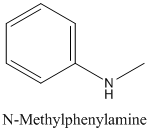
(b)
Interpretation:
Determine the structural formula from the given molecular formula:
30 aromatic amines, C8 H11 N.
Concept Introduction:
The spatial arrangement of atom within a compound that are joined together is identified with the help of structural formula.
Explanation of Solution
Tertiary amines are those compounds in which three hydrogen atoms of ammonia are replaced by alkyl or aryl groups. They are represented as R3 -N or 
The molecular formula, C8 H11 N is 30 on the aromatic amine. Hence, it has six-membered ring. The nitrogen atom is attached to three groups in which one is an aryl group and the other two are methyl groups.
Thus, the structural formula for the molecular formula C8 H11 N is as below:
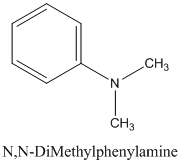
(c)
Interpretation:
Determine the structural formula from the given molecular formula:
10 aliphatic amines, C7 H9 N.
Concept Introduction:
The spatial arrangement of atom within a compound that are joined together is identified with the help of structural formula.
Explanation of Solution
Primary amines are those compounds in which one of the hydrogen atoms of ammonia is replaced by an alkyl or an aryl group. They are represented as 
The molecular formula C7 H9 N is 10 on the aliphatic amine. Hence it has
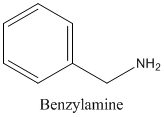
(d)
Interpretation:
Determine the structural formula from the given molecular formula:
A chiral 10 amine, C4 H11 N.
Concept Introduction:
The spatial arrangement of atom within a compound that are joined together is identified with the help of structural formula.
Explanation of Solution
Primary amines are those compounds in which one of the hydrogen atoms of ammonia is replaced by an alkyl or aryl group. They are represented as
The carbon atom attach to four different group is called a chiral atom. When a molecule possesses such atom, then they are not superimposable on their mirror image.
The molecular formula C4 H11 N is 10 on the aliphatic amine, and it is a chiral molecule. Hence, the chiral carbon atom is attached to four different groups, which include -NH2 group, the -CH3 group, the -CH2 group and the -H group. The structural formula of C4 H11 N is as below:
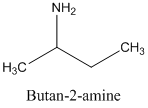
(e)
Interpretation:
Determine the structural formula from the given molecular formula:
A 30 heterocyclic amine, C5 H11 N.
Concept Introduction:
The spatial arrangement of atom within a compound that are joined together is identified with the help of structural formula.
Explanation of Solution
Tertiary amines are those compounds in which three hydrogen atoms of ammonia are replaced by alkyl or aryl groups. They are represented as R3 -N or 
The carbon atom attach to four different group is called a chiral atom. When a molecule possesses such atom, then they are not superimposable on their mirror image.
The molecular formula C5 H11 N is 30 on the heterocyclic amine. This structure has a five membered heterocyclic ring. This ring contains four carbons and one nitrogen atom. The nitrogen atom in the ring is bonded to the methyl group. The structural formula of C4 H11 N is as below:

(f)
Interpretation:
Determine the structural formula from the given molecular formula:
A trisubstituted 10 aromatic amine, C9 H13 N.
Concept Introduction:
The spatial arrangement of atom within a compound that are joined together is identified with the help of structural formula.
Explanation of Solution
Primary amines are those compounds in which one of the hydrogen atoms of ammonia is replaced by an alkyl or aryl group. They are represented as
The molecular formula C9 H13 N is tri substituted 10 on the aromatic amine. Hence, it has six membered rings with three methyl groups. The structural formula of C5 H13 N is as below:
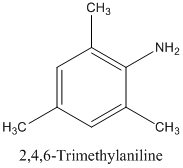
(g)
Interpretation:
Determine the structural formula from the given molecular formula:
A chiral quaternary ammonium salt, C9 H22 NCl.
Concept Introduction:
The spatial arrangement of atom within a compound that are joined together is identified with the help of structural formula.
Explanation of Solution
Quaternary amines are those compounds in which all four of the hydrogen atoms of the ammonium ion are replaced by an alkyl or aryl group. It is an ionic quaternary salt.
When the carbon atom is attached to four different groups, it is called a chiral atom. When a molecule possesses such an atom, then it is not super imposable on its mirror image.
The molecular formula C9 H22 NCl is a quaternary amine and it is a chiral molecule. Hence, the chiral nitrogen atom is attached to four different groups, which include -CH2 CH3 group, the -CH2 CH2 CH3 group, the -CH3 CHCH3 group, and the -CH3 group. Therefore, the quaternary ammonium salt of C9 H22 NCl is as below:
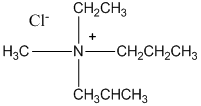
Want to see more full solutions like this?
Chapter 16 Solutions
Introduction to General, Organic and Biochemistry
- Correct each molecule in the drawing area below so that it has the skeletal ("line") structure it would have if it were dissolved in a 0.1 M aqueous solution of HCI. If there are no changes to be made, check the No changes box under the drawing area. No changes. HO Explanation Check NH, 2 W O :□ G ©2025 M unter Accessibilityarrow_forwardAn expression for the root mean square velocity, vrms, of a gas was derived. Using Maxwell’s velocity distribution, one can also calculate the mean velocity and the most probable velocity (mp) of a collection of molecules. The equations used for these two quantities are vmean=(8RT/πM)1/2 and vmp=(2RT/M)1/2 These values have a fixed relationship to each other.(a) Arrange these three quantities in order of increasing magnitude.(b) Show that the relative magnitudes are independent of the molar mass of the gas.(c) Use the smallest velocity as a reference for establishing the order of magnitude and determine the relationship between the larger and smaller values.arrow_forwardThe reaction of solid dimethylhydrazine, (CH3)2N2H2, and liquefied dinitrogen tetroxide, N2O4, has been investigated for use as rocket fuel. The reaction produces the gases carbon dioxide (CO2), nitrogen (N2), and water vapor (H2O), which are ejected in the exhaust gases. In a controlled experiment, solid dimethylhydrazine was reacted with excess dinitrogen tetroxide, and the gases were collected in a closed balloon until a pressure of 2.50 atm and a temperature of 400.0 K were reached.(a) What are the partial pressures of CO2, N2, and H2O?(b) When the CO2 is removed by chemical reaction, what are the partial pressures of the remaining gases?arrow_forward
- One liter of chlorine gas at 1 atm and 298 K reacts completely with 1.00 L of nitrogen gas and 2.00 L of oxygen gas at the same temperature and pressure. A single gaseous product is formed, which fills a 2.00 L flask at 1.00 atm and 298 K. Use this information to determine the following characteristics of the product:(a) its empirical formula;(b) its molecular formula;(c) the most favorable Lewis formula based on formal charge arguments (the central atom is N);(d) the shape of the molecule.arrow_forwardHow does the square root mean square velocity of gas molecules vary with temperature? Illustrate this relationship by plotting the square root mean square velocity of N2 molecules as a function of temperature from T=100 K to T=300 K.arrow_forwardDraw product B, indicating what type of reaction occurs. F3C CF3 NH2 Me O .N. + B OMearrow_forward
- Benzimidazole E. State its formula. sState the differences in the formula with other benzimidazoles.arrow_forwardDraw product A, indicating what type of reaction occurs. F3C CN CF3 K2CO3, DMSO, H₂O2 Aarrow_forward19) Which metal is most commonly used in galvanization to protect steel structures from oxidation? Lead a. b. Tin C. Nickel d. Zinc 20) The following molecule is an example of a: R₁ R2- -N-R3 a. Secondary amine b. Secondary amide c. Tertiary amine d. Tertiary amidearrow_forward
 Introduction to General, Organic and BiochemistryChemistryISBN:9781285869759Author:Frederick A. Bettelheim, William H. Brown, Mary K. Campbell, Shawn O. Farrell, Omar TorresPublisher:Cengage Learning
Introduction to General, Organic and BiochemistryChemistryISBN:9781285869759Author:Frederick A. Bettelheim, William H. Brown, Mary K. Campbell, Shawn O. Farrell, Omar TorresPublisher:Cengage Learning Organic ChemistryChemistryISBN:9781305580350Author:William H. Brown, Brent L. Iverson, Eric Anslyn, Christopher S. FootePublisher:Cengage Learning
Organic ChemistryChemistryISBN:9781305580350Author:William H. Brown, Brent L. Iverson, Eric Anslyn, Christopher S. FootePublisher:Cengage Learning Chemistry: The Molecular ScienceChemistryISBN:9781285199047Author:John W. Moore, Conrad L. StanitskiPublisher:Cengage Learning
Chemistry: The Molecular ScienceChemistryISBN:9781285199047Author:John W. Moore, Conrad L. StanitskiPublisher:Cengage Learning General, Organic, and Biological ChemistryChemistryISBN:9781285853918Author:H. Stephen StokerPublisher:Cengage Learning
General, Organic, and Biological ChemistryChemistryISBN:9781285853918Author:H. Stephen StokerPublisher:Cengage Learning Organic And Biological ChemistryChemistryISBN:9781305081079Author:STOKER, H. Stephen (howard Stephen)Publisher:Cengage Learning,
Organic And Biological ChemistryChemistryISBN:9781305081079Author:STOKER, H. Stephen (howard Stephen)Publisher:Cengage Learning, ChemistryChemistryISBN:9781305957404Author:Steven S. Zumdahl, Susan A. Zumdahl, Donald J. DeCostePublisher:Cengage Learning
ChemistryChemistryISBN:9781305957404Author:Steven S. Zumdahl, Susan A. Zumdahl, Donald J. DeCostePublisher:Cengage Learning





